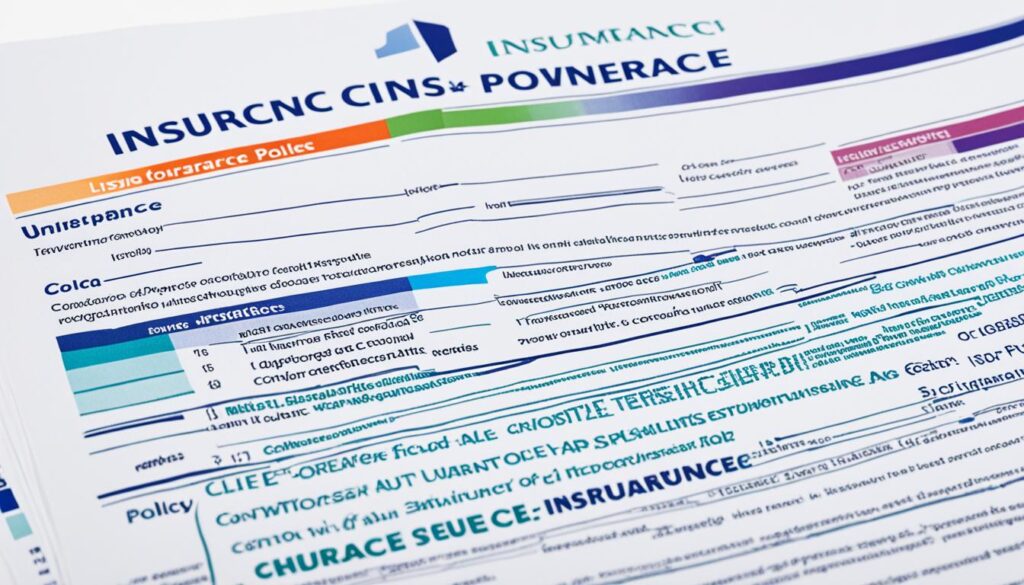In today’s world, having the right insurance is key to protecting you, your loved ones, and your stuff. Whether you need health, life, auto, or homeowners insurance, it’s important to know what you need. With many factors to think about, like risk assessment and claims processing, finding the right insurance can feel tough.
But, by looking at your risk and choosing the right coverage, you can make sure you’re protected when it matters most. The average cost of a full coverage policy is $1,895 a year1. Collision insurance usually costs about $60 a month. The price depends on your age, gender, where you live, your driving record, credit score, the type of car you drive, how much you drive, and the coverages and limits you choose1.
Mental health issues can also affect your insurance costs. Most Americans think there’s a mental health crisis, and many adults have felt anxiety or depression2. Insurance companies usually don’t deny coverage to people with mental health issues. But, conditions like schizophrenia, bipolar disorder, depression, anxiety, and PTSD can make life insurance more expensive2.
Understanding what you need in insurance, looking at different options, and comparing prices from trusted companies can help you find the right coverage. Remember, getting the right insurance is a way to secure your future and give you peace of mind.
Key Takeaways
- Assess your risk profile and determine the appropriate level of coverage for your needs
- Consider factors like age, gender, location, and driving record when evaluating auto insurance costs
- Be aware that mental health conditions can impact insurance coverage and pricing
- Compare quotes from multiple providers to find the best policy options for your circumstances
- Investing in the right insurance coverage is crucial for protecting yourself, your loved ones, and your assets
Understanding Your Insurance Needs
Protecting yourself, your loved ones, and your assets is key. It’s vital to know what insurance you need. This means understanding your risk profile and insurance needs.

Assessing Your Risk Profile
Your risk profile helps decide how much insurance you need. It looks at your age, health, job, lifestyle, and money situation. For instance, living in an area prone to wildfires means you might need more homeowners insurance.
State Farm and Allstate have asked for 30% and 34% rate hikes in California due to wildfire risks3. Farmers is stopping new sales in California for the same reason3.
If your family depends on your income, you might need more life insurance. Term insurance is a good option for this. It covers a set period, like 10 to 30 years, and is cheaper than permanent insurance4.
Determining the Right Coverage Amount
After looking at your risk profile, figure out how much insurance you need. Think about your assets, debts, and what you might owe if something unexpected happens. For homeowners insurance, check your coverage often to make sure it matches building costs and protects you well3.
For life insurance, aim for coverage that replaces your income and pays off debts like mortgages or loans if you pass away4. Term insurance lets you change your coverage as your financial needs change4.
Don’t be cheap with insurance. Choosing a higher deductible lowers your monthly payments. But, be careful not to cut your coverage too much, or you could face big costs if disaster strikes3.
By carefully assessing your risk profile and coverage needs, you can make sure you’re well-protected. This way, you and your loved ones will be financially secure and at peace.
Types of Insurance Policies
Protecting yourself, your loved ones, and your assets is key. There are many policy types to choose from. It’s vital to know your options to get the right coverage.

Health Insurance
Health insurance is key for covering medical costs like doctor visits and hospital stays. In the U.S., you can get it from employers, the Health Insurance Marketplace, or government programs like Medicare and Medicaid. Make sure to check your policy for details on coverage and costs.
Life Insurance
Life insurance helps your loved ones financially if you pass away suddenly. It comes in two forms: term and whole life insurance. The coverage you need depends on your income, debts, and future financial plans.
Auto Insurance
Auto insurance is a must in most places and covers you in case of accidents or theft. A basic policy usually includes liability coverage for others’ damages or injuries from an accident you cause. You can also add collision, comprehensive, and personal injury protection. In Ukraine, car owners must have compulsory motor third party liability insurance, but other types are optional5.
Homeowners Insurance
Homeowners insurance protects your home and stuff from damage or loss due to fires, theft, or disasters. It typically covers your home, belongings, liability, and extra living costs. Always read your policy carefully to understand what’s covered and what’s not5.
In California, big insurers like State Farm and Allstate want to raise rates on homeowners insurance. State Farm is asking for a 30% increase after a 20% hike last year, and Allstate wants a 34% hike3. To get the best deal, homeowners should compare quotes from three to five companies before making a choice3.
| Policy Type | Key Features |
|---|---|
| Health Insurance | Covers medical expenses, hospital stays, and prescription medications |
| Life Insurance | Provides financial protection for loved ones in case of unexpected death |
| Auto Insurance | Protects against accidents, theft, and damage to your vehicle |
| Homeowners Insurance | Safeguards your home and personal property against losses or damages |
Knowing about the different insurance policies and what you need is crucial. This way, you can make sure you and your loved ones are well-protected.
Choosing the Right Insurance Provider
When picking an insurance provider, it’s key to do your homework. This ensures you get the best coverage at a good price. Researching and comparing different companies can save you money and give you peace of mind.

Researching Insurance Companies
Start by researching several insurance companies. Make sure they’re licensed in your state and financially strong5. Check ratings from independent agencies to see how well they handle claims5. For example, Berkshire Hathaway’s investment in Chubb shows it’s financially solid6.
Look at their reputation for customer service, claims handling, and policy options. Reading reviews and checking with your state’s insurance department can tell you if they’re reliable3.
Comparing Quotes and Coverage Options
After picking a few companies, ask for quotes from at least three of them. Make sure the details like coverages and deductibles are the same for a fair comparison3.
Things like your age, gender, and driving record affect your insurance costs. Use online tools to easily get quotes from several companies at once.
California homeowners should get quotes from three to five companies to find the best deal, considering coverage and customer reviews3.
Think about what you need and your risk level when looking at coverage options. If you live where wildfires happen, make sure your policy covers that risk. Some companies offer discounts for fire-resistant homes3.
Choosing a higher deductible can lower your monthly payments, but you’ll pay more if you make a claim3. Find a balance between affordable premiums and enough coverage to protect your stuff.
Check your insurance regularly to make sure it still fits your needs and budget. This is especially true for homeowners, as costs and coverage needs can change over time3.
By doing your homework and comparing options, you can find the right insurance provider. This way, you’ll be protected and save money.
Insurance for Different Life Stages
As you move through life, your insurance needs change. It’s key to check your coverage often. This makes sure it fits your current life and protects you well. Let’s see how insurance changes for young adults, families, and retirees.
Insurance for Young Adults
Young adults, especially those starting their careers, have special insurance needs. If you’re a recent college grad, you might get TRICARE Young Adult coverage until you’re 26. This is great as you start working and getting financially stable. Also, think about getting renters insurance for your stuff and liability coverage for legal protection7.
Insurance for Families
Starting a family means your insurance needs grow. Make sure your kids are signed up for DEERS and a TRICARE health plan for their health. Life insurance is key to protect your family’s finances if something unexpected happens. Also, check your auto and homeowners insurance to cover more assets and risks from having a family8.
Insurance for Retirees
Retirement changes your insurance needs a lot. You’ll need to review and adjust your coverage for health and lifestyle changes. Medicare is a main health insurance for retirees, but you might need extra plans to cover gaps. Think about long-term care insurance for future care costs. Retirees should also check their life insurance to make sure it matches their financial goals and plans for the future9.
